How to Get Rid of Grass in Vegetable Garden Naturally
- January 12, 2024
- 0 comment
Growing a successful vegetable garden requires attention to detail, and one common issue for gardeners is dealing with unwanted grass. The fast growth of grass can compete with the nutrients and water your vegetable plants need, putting their health at risk. The good news is there are natural ways to tackle this problem without using harsh chemicals.
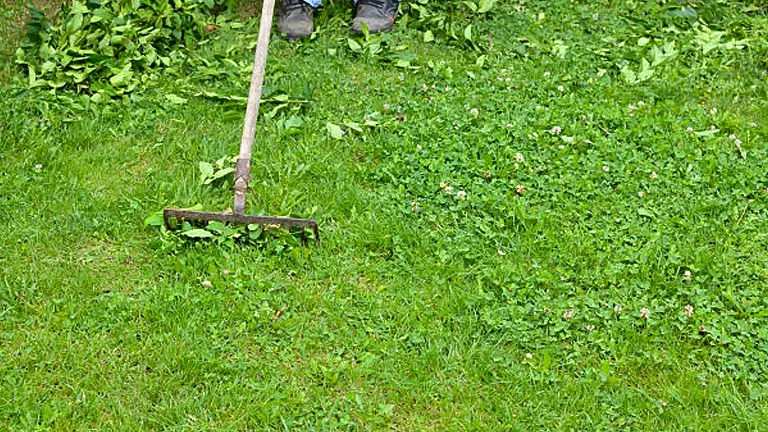
In this guide, we’ll explore simple and eco-friendly strategies to get rid of grass in your vegetable garden. From basic manual removal to techniques like mulching and companion planting, these natural methods will help you create a healthy and sustainable environment for your garden. Let’s look into these gentle yet effective ways to keep your garden thriving without the hassle of unwanted grass.
List of Guides on How to Get Rid of Grass in Vegetable Garden Naturally
- Manual Removal with a Shovel
- Use a Sod Cutter
- Till the Lawn Under
- Hire Professional Help
- Deep Mulch & Sheet Mulching
- Solarizing Grass
- Ground Cover Options
Why is it Important to Get Rid of Grass in Your Vegetable Garden?
Eliminating grass from your vegetable garden is crucial for several reasons, each rooted in the well-being and productivity of your garden. Grass, even if healthy, like Ryegrass, poses a threat by absorbing essential nutrients such as fertilizer, soil, and water intended for the optimal growth of your vegetables. This competition for vital resources can hinder the flourishing of your vegetable crops. However, the issue intensifies as grass often brings along troublesome weeds, including crabgrass and nutgrass. These invasive weeds not only perpetuate nutrient theft but also act as safe havens for diseases and pests that can easily spread, posing an imminent threat to the overall health of your garden.

Beyond its interference with the growth of vegetables, grass, when left unchecked, becomes a relentless invader that, if not addressed, can overwhelm the entire vegetable patch. Therefore, the mission to get rid of grass becomes not just a matter of aesthetics but a fundamental step in ensuring the prosperity and vitality of your vegetable garden. By employing effective and natural removal methods, you not only reclaim control over your garden space but also create an environment where your vegetables can thrive unhindered by the encroachment of grass and its associated challenges.
Here are the Ways to Get Rid of Grass in a Vegetable Garden Naturally
1. Manual Removal with a Shovel
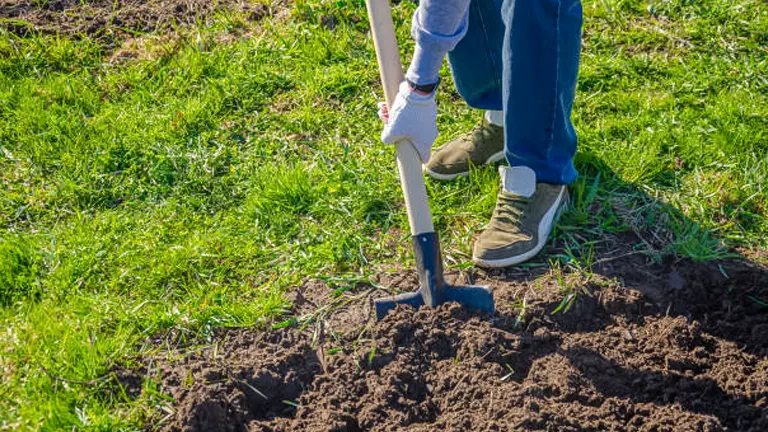
One effective method to reclaim your vegetable garden from grass invasion is manual removal using a shovel. This approach is particularly suitable for smaller spaces or areas with obstacles. By cutting deep lines into the sod with a flat-edge shovel, you can systematically lift and remove the grass. This labor-intensive process ensures that the grass is completely uprooted, preventing it from re-growing. To enhance the effectiveness of this method, ensure the soil is adequately moist before attempting manual removal. Wet soil makes it easier to cut through the grass and minimizes soil disruption. Additionally, consider composting the removed grass to recycle nutrients back into your garden soil.
Additional Tips:
- Early Morning or Late Evening: Opt for manual removal during the early morning or late evening when temperatures are cooler. This minimizes stress on both you and the plants in your garden.
- Sharpen Your Shovel: Before starting, ensure your shovel has a sharp edge. This makes the cutting process smoother and reduces strain on your muscles.
- Dispose Properly: If the grass you’re removing is infested with weeds or pests, dispose of it properly to prevent the spread of unwanted elements. Avoid composting if the grass is diseased.
- Divide and Conquer: Work in sections, dividing your garden into manageable areas. This prevents overwhelming yourself and ensures thorough removal.
- Use Knee Pads or a Kneeler: Protect your knees by using knee pads or a gardening kneeler. This is especially useful when dealing with a larger area, and it reduces discomfort during the process.
2. Use a Sod Cutter

If you prefer a more efficient approach, using a sod cutter can save time and effort. Sod cutters, whether manual tools or engine-powered machines, cleanly cut the grass into strips. This method allows you to roll up the sod for disposal or potential reuse in other areas. However, caution is needed to avoid damaging irrigation lines or sprinkler heads during the process.
Additional Tips:
- Moisten the Soil: Water the area a day before using a sod cutter. Moist soil makes the cutting process smoother and reduces resistance, making it easier to lift the sod.
- Check for Irrigation Lines: Before operating a sod cutter, identify the location of irrigation lines or any other underground utilities. This prevents accidental damage during the cutting process.
- Plan the Removal Path: Decide where you’ll roll up and dispose of the removed sod before starting. This prevents unnecessary dragging across the garden and minimizes disturbance to surrounding plants.
- Adjust Cutter Depth: Set the sod cutter to the appropriate depth based on the thickness of the grass and roots. This ensures efficient cutting without going too deep into the soil.
- Collaborate with Garden Design: If you plan to redesign your garden layout, using a sod cutter provides an opportunity to reshape the space. Collaborate with a garden designer to plan the new layout before cutting the sod.
3. Till the Lawn Under
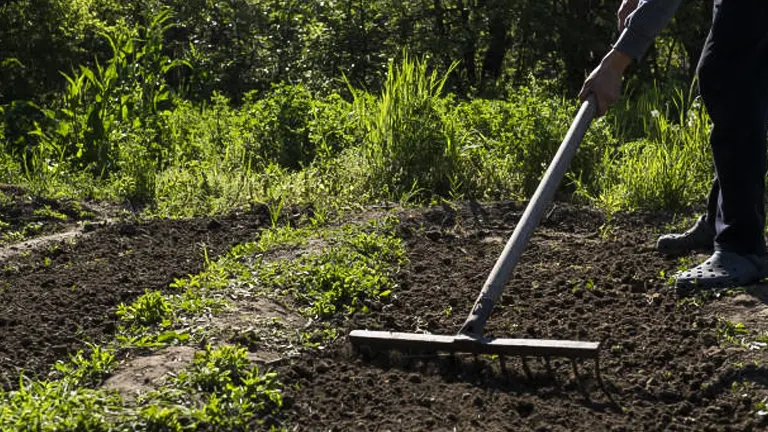
Breaking up the grass by tilling it in place is another strategy. While it may require physical effort, hand-operated tillers or motor-powered rototillers can be used for this purpose. This method is suitable for incorporating grass into the soil, avoiding the need for disposal. However, tilling may promote weed seed propagation and is not recommended for persistent creeping grasses like crabgrass.
Additional Tips:
- Choose the Right Time: Opt for tilling when the soil is moist but not overly wet. This makes the process more effective and prevents soil compaction.
- Consider Amendments: Before tilling, consider adding organic amendments like compost to enhance soil fertility. This contributes to a healthier growing environment for future plants.
- Monitor Weed Growth: Keep a close eye on the tilled area for any signs of weed growth. If weeds appear, promptly remove them to prevent competition with desired plants.
- Rotate Tilling Depth: To thoroughly break up grass and soil compaction, rotate the tilling depth periodically. This ensures an even distribution of organic matter and promotes aeration.
- Follow Up with Mulch: After tilling, apply a layer of organic mulch to suppress weed growth and conserve soil moisture. This also contributes to the breakdown of grass remnants over time.
4. Hire Professional Help
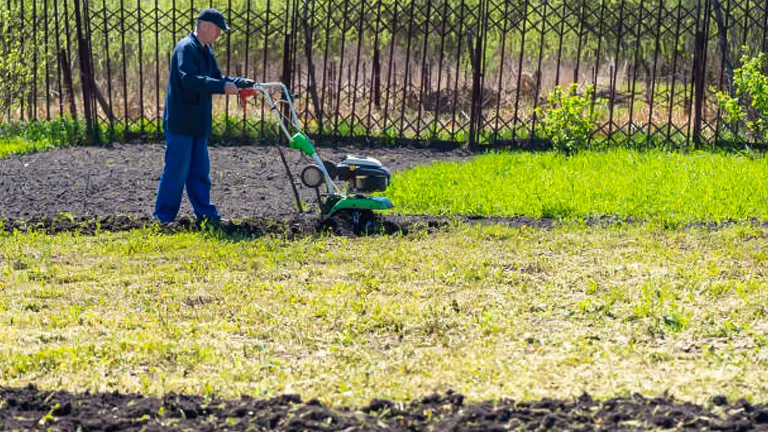
For those who prefer a quicker and less physically demanding option, hiring professional help is a viable choice. Local landscape companies often provide grass removal services. While this option involves a cost, it ensures a swift and effective resolution, particularly in larger areas. Alternatively, consider enlisting nature’s help by allowing chickens to forage in the garden, gradually reducing the grassy areas.
Additional Tips:
- Research Local Services: Before hiring professionals, research local landscaping services to find reputable and experienced providers. Check reviews and ask for recommendations to ensure quality service.
- Discuss Sustainable Practices: If hiring a landscaping service, inquire about sustainable practices. Some companies may offer eco-friendly alternatives or practices that align with your environmental preferences.
- Coordinate with Garden Plans: If you have specific plans for your garden layout or future plantings, communicate these to the professionals. This ensures that grass removal aligns with your overall garden design.
- Explore Eco-friendly Options: Some landscaping companies offer eco-friendly approaches to grass removal, such as natural herbicides or organic methods. Inquire about these options for a more environmentally conscious choice.
- Consider Chickens for Natural Control: If applicable, consider introducing chickens to your garden. Chickens naturally forage for insects and grass, helping to control unwanted vegetation. This can be a sustainable and organic way to manage grass in your garden.
5. Deep Mulch & Sheet Mulching
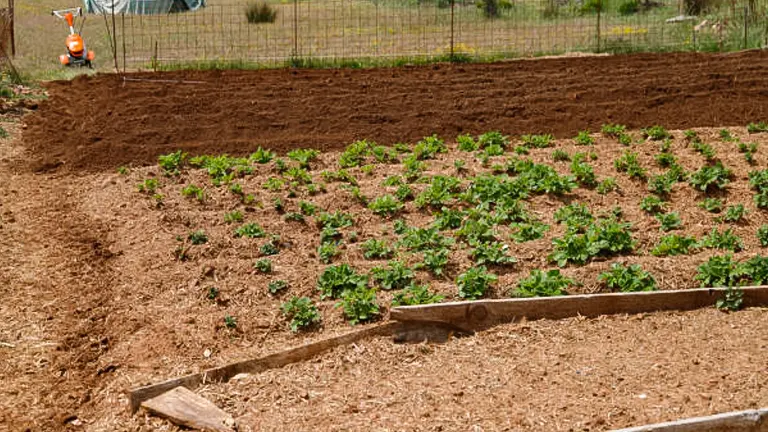
Smothering grass in place is a natural and sustainable method. By applying a thick layer of mulch material such as leaves, wood chips, or compost, you block sunlight and smother the grass. Adding layers of newspaper or cardboard beneath the mulch enhances the smothering effect. Over time, the grass dies, and the decomposing mulch enriches the soil, preparing it for future planting.
Additional Tips:
- Choose Organic Mulch Materials: Opt for organic mulch materials like straw, leaves, or compost. These materials not only suppress grass effectively but also contribute valuable nutrients to the soil as they break down.
- Layer with Newspaper or Cardboard: Enhance the smothering effect by layering newspaper or cardboard beneath the mulch. This prevents sunlight from reaching the grass, accelerating its demise. Ensure that the newspaper or cardboard is thick enough to block light effectively.
- Water the Area: Before applying mulch, moisten the area to encourage decomposition and help the mulch settle. Adequate moisture enhances the breakdown of organic materials and promotes a healthier soil environment.
- Monitor and Adjust Mulch Thickness: Regularly check the progress of grass suppression. If needed, add more mulch to maintain a sufficient thickness and ensure ongoing control. Adjust the mulch layer as necessary based on the resilience of the grass and environmental conditions.
- Integrate with Planting Plans: Plan your mulching strategy in coordination with your planting schedule. Leave openings in the mulch for planting new crops or flowers, ensuring a seamless transition from grass removal to garden cultivation.
6. Solarizing Grass
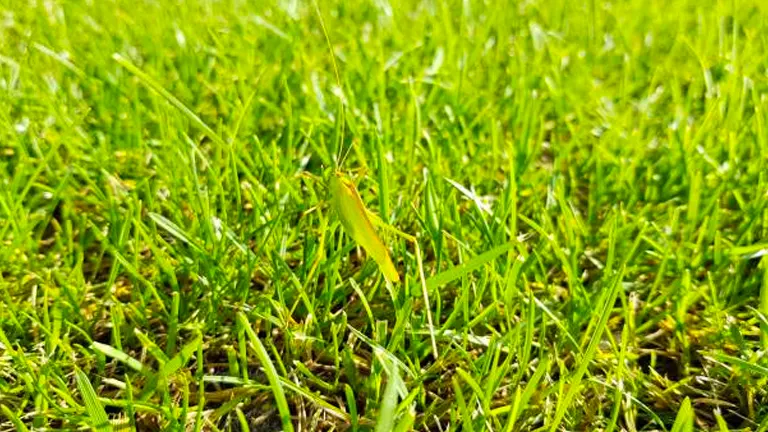
Solarization involves covering the grass with clear plastic to harness the sun’s heat and sterilize the soil. While effective in theory, success may vary based on climate and technique. It is a suitable method for killing grass, weeds, and seeds. However, the extensive use of plastic and potential challenges in completely solarizing the lawn make this method a mixed bag.
Additional Tips:
- Choose the Right Plastic: Use clear plastic specifically designed for solarization. The plastic should be thick enough to trap heat effectively. Clear plastic allows sunlight penetration while trapping heat to create a greenhouse effect, raising soil temperatures and accelerating grass elimination.
- Prepare the Area Thoroughly: Before solarizing, remove debris, weeds, and large rocks from the area to ensure direct contact between the soil and the plastic. The more direct the contact, the better the heat transfer, enhancing the effectiveness of the solarization process.
- Water the Soil: Moistening the soil before applying the plastic improves heat conductivity. Water the area a day or two before covering it. However, be cautious not to oversaturate, as excessively wet soil may hinder the solarization process.
- Secure the Edges: To maximize heat retention, secure the edges of the plastic with soil, rocks, or other weights. This prevents heat from escaping and ensures consistent coverage. Check periodically to ensure the plastic remains in place throughout the solarization period.
- Time it Right: Opt for solarization during the hottest months, typically in midsummer. The combination of high temperatures and prolonged sunlight exposure enhances the efficiency of this grass removal method. Keep in mind that success may vary based on regional climate conditions.
7. Ground Cover Options

Choosing the right ground cover is crucial after removing grass. Options like weed barrier landscape fabric, cardboard, or paper act as effective barriers against weed regrowth. Landscape fabric, when of commercial-grade quality, provides durable and long-lasting protection. Alternatively, using cardboard or paper is a more natural and biodegradable approach, fostering a healthier soil ecosystem.
Additional Tips:
- Proper Installation: Ensure proper installation of the chosen ground cover. For landscape fabric, secure it tightly to prevent weed penetration. Overlap seams and use landscape fabric pins or staples to keep it in place. If using cardboard or paper, layer them adequately, moisten slightly, and cover with mulch to enhance effectiveness.
- Choose the Right Material: Select ground cover materials based on your garden’s specific needs. Commercial-grade landscape fabric is effective in high-traffic areas, while cardboard or paper may be more suitable for smaller, less-trafficked spaces. Consider the intended use and aesthetics when making your choice.
- Monitor and Replace: Regularly monitor the condition of the ground cover. In areas with extreme weather conditions, such as heavy rainfall or intense sunlight, the cover may degrade over time. Replace damaged or deteriorated sections promptly to maintain effective weed control.
- Combine with Mulch: Enhance the effectiveness of ground cover by combining it with a layer of organic mulch. This not only provides additional weed suppression but also contributes to soil health by promoting moisture retention and preventing erosion.
- Consider Permeable Options: If moisture penetration is a concern, opt for permeable ground cover materials. This allows water and nutrients to reach the soil while still providing an effective barrier against weed growth. Evaluate the specific needs of your garden to choose the most suitable ground cover option.
Remember that selecting the most appropriate method depends on factors such as grass type, garden design, irrigation considerations, and desired landscaping features. Each approach comes with its advantages and considerations, ensuring you can tailor the solution to your specific needs and preferences.
Factors to Consider Grass Removal vs. Landscaping: Key Considerations
When deciding whether to remove your grass entirely or simply landscape over it, several crucial factors come into play, influencing the outcome of your gardening endeavor.
- Existing Grass Health: The first factor to consider is the current health of your grass. If your lawn is overrun with unwanted grass varieties or plagued by persistent weeds, a complete removal might be necessary. This ensures a fresh start for a healthier and more vibrant garden. On the other hand, if your existing grass is relatively healthy and free from invasive species, landscaping over it might be a viable option.
- Nutrient Competition: Grass, even if healthy, can be a voracious consumer of essential nutrients like fertilizers, water, and soil. In a vegetable garden, where these nutrients are critical for robust plant growth, removing grass becomes essential. Grass competes with your vegetables for these resources, potentially hindering their development. By eliminating the grass, you create an environment where your vegetables can thrive without nutrient competition.
- Weed Infestation Risk: Grass often provides a conducive environment for the growth of weeds such as crabgrass and nutgrass. These invasive plants can quickly spread and steal nutrients from both the grass and your vegetables. If weed infestation is a persistent issue, complete grass removal becomes a strategic move to break the cycle and prevent future weed-related challenges in your garden.
- Chemical Herbicide Risks: While herbicides are available for weed control, they pose a risk when used in vegetable gardens. Chemicals present in herbicides can be absorbed by vegetables, making them unsuitable for consumption. This risk reinforces the importance of exploring natural and organic methods for grass and weed control in a vegetable garden.
- Mulching Benefits: Utilizing mulching materials in your garden not only helps control grass growth but also contributes to overall soil health. Mulch, made from materials like newspapers or cardboard, blocks sunlight, preventing weed and grass growth. As it decomposes, it transforms into nutrient-rich compost, enhancing the fertility of the soil.
- Solar Sterilization Considerations: Solar sterilization, involving covering the area with dark plastic to harness the sun’s heat, can effectively control grass and weed growth. However, its success may vary based on climate and technique. This method is particularly suitable during the hottest summer months but requires careful execution for optimal results.
- Future Garden Design: Your decision to remove grass or landscape over it should align with your future garden design plans. If you envision a well-organized vegetable patch with minimal interference from grass, opting for removal is a strategic choice. Conversely, if you plan to incorporate pathways or mixed landscaping with existing grassy areas, landscaping over might be a more practical approach.
Considering these factors provides a holistic perspective, guiding you toward the most suitable decision for your vegetable garden.
Conclusion
In conclusion, achieving a grass-free vegetable garden involves adopting a thoughtful and diverse approach. Embrace natural methods like manual removal, specialized tools, eco-friendly herbicides, and organic mulching to eliminate grass while fostering a healthier vegetable environment. Consider factors such as existing grass health, nutrient competition, and weed infestation risk in your decision-making. Whether you choose hands-on techniques, professional help, or nature-based processes like solarization, strive for a balanced approach that nurtures your garden without harming the ecosystem. The journey to a thriving, grass-free vegetable garden is both practical and eco-conscious.
FAQs
- Can I use chemical herbicides to get rid of grass in my vegetable garden?
While chemical herbicides are available, they pose risks as they may be absorbed by vegetables, making them unsuitable for consumption. Consider natural alternatives like organic herbicides, citrus-based weed killers, or corn gluten. - Is manual removal a time-consuming method to eliminate grass in a vegetable garden?
Manual removal can be labor-intensive, especially for larger areas, but it ensures thorough uprooting of grass. For smaller spaces or precision around vegetables, it’s an effective and precise method. - Can solarization be effective in any climate for grass removal?
Solarization’s effectiveness varies based on climate and technique. It’s generally more successful in hot climates during the summer months. However, challenges may arise, making it a method with mixed results. - What ground cover options are best after grass removal?
Consider using weed barrier landscape fabric, cardboard, or paper as ground covers. Commercial-grade landscape fabric provides durable protection, while cardboard and paper offer natural and biodegradable alternatives. - Is tilling a suitable method for incorporating grass into the soil?
Tilling is effective for breaking up grass and incorporating it into the soil. However, it may promote weed seed propagation and isn’t recommended for persistent creeping grasses like crabgrass. - How can I prevent grass regrowth after removal?
After grass removal, use deep mulch with materials like leaves or wood chips. Adding newspaper or cardboard beneath the mulch further blocks sunlight, aiding in preventing grass regrowth. - Are there eco-friendly herbicides safe for vegetable gardens?
Yes, options like Avenger Organic Weed Killer are safe for vegetable gardens, effectively targeting weeds without harming vegetables. Always choose herbicides that are labeled as safe for edible plants. - Can hiring professional help expedite the grass removal process?
Yes, hiring professionals is a quicker option, especially for larger areas. Local landscape companies often provide grass removal services, ensuring a swift and effective resolution. Alternatively, allowing chickens to forage can be a natural and gradual approach.
As you embark on your journey to reclaim your vegetable garden from invasive grass, remember that the path to a thriving, natural haven is both fulfilling and eco-conscious. Whether you choose the hands-on approach or seek professional assistance, each method contributes to a healthier environment for your vegetables. Consider the unique needs of your garden, factor in sustainability, and enjoy the rewards of a lush, grass-free vegetable haven. Happy gardening!

Benjamin Brooks
Forestry AuthorGreetings! I'm Benjamin Brooks, and my journey over the past 15 years has revolved around the fascinating realms of content creation, expertise in snow clearing, and the intricate world of lumberjacking and landscaping. What began as a simple curiosity about the natural world and heavy machinery has evolved into a passionate profession where my love for crafting words intertwines seamlessly with my lumberjacking and garden skills.






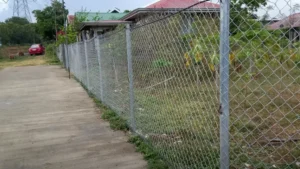
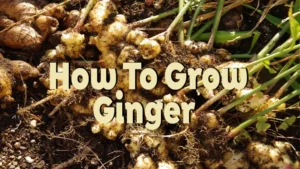

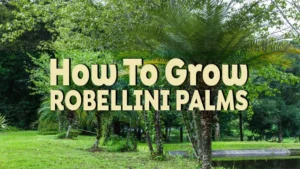

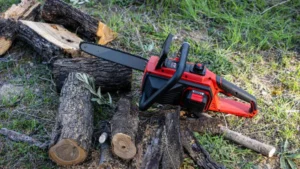
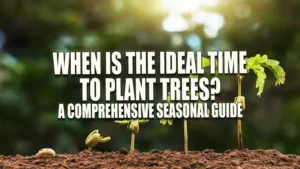
Leave your comment